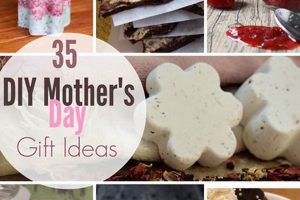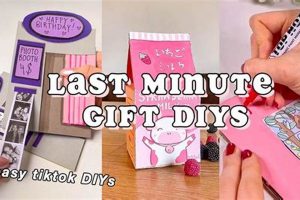The concept involves the creation of personalized containers filled with thoughtfully selected items, tailored to the recipient’s preferences and interests. A completed example may feature a collection of gourmet snacks for a food enthusiast or a selection of bath and body products for someone who enjoys relaxation.
This approach to gift-giving offers numerous advantages, including cost-effectiveness, personalization, and the opportunity to express creativity. Historically, handcrafted presents have held significant cultural value, representing a personal investment of time and effort beyond mere monetary worth. The practice allows for the customization of the gift to align precisely with the recipient’s needs and tastes, resulting in a more meaningful and appreciated gesture.
The following sections will delve into various themes and techniques for constructing these personalized present assemblages, offering practical guidance on selecting appropriate contents, arranging items attractively, and incorporating finishing touches to enhance the overall presentation.
Assembling Thoughtful Handcrafted Present Collections
The creation of customized gift collections requires careful planning and execution to ensure a present that is both aesthetically pleasing and genuinely appreciated.
Tip 1: Theme Selection: Establish a central theme to guide the selection of items. A “coffee lover’s collection,” for example, might include artisanal coffee beans, a French press, and a selection of biscotti.
Tip 2: Content Quality: Prioritize quality over quantity. A smaller selection of high-end items will often be more appreciated than a larger assortment of lower-quality goods. For instance, opt for a single, well-crafted item from a local artisan instead of several mass-produced objects.
Tip 3: Presentation Matters: The arrangement of items within the container significantly impacts the overall impression. Utilize filler materials such as tissue paper or shredded paper to elevate items and create visual interest.
Tip 4: Personalization is Key: Incorporate personalized elements that reflect the recipient’s individual preferences. This could involve including a handwritten note, a customized item, or items that reflect their hobbies or interests.
Tip 5: Practicality and Utility: Consider the practicality and usefulness of the included items. Focus on items that the recipient will genuinely use and appreciate in their daily life.
Tip 6: Packaging Considerations: Select a container that complements the theme and is reusable. Wicker containers, decorative boxes, or even repurposed containers can enhance the presentation and provide lasting value.
Tip 7: Budget Management: Establish a budget and adhere to it. It is possible to create a thoughtful and impressive collection without exceeding financial constraints. Prioritize items that offer the most value within the established budget.
By adhering to these guidelines, it is possible to create memorable and personalized present collections that demonstrate thoughtfulness and care.
The subsequent section will discuss the art of wrapping and presenting these customized gifts to maximize their impact.
1. Personalization
Personalization represents a critical component in the successful execution of handcrafted present collections. It transforms a generic offering into a highly tailored expression of thoughtfulness, aligning the gift with the recipient’s specific preferences and needs.
- Preference Mapping
Involves a thorough understanding of the recipient’s likes, dislikes, hobbies, and interests. This informs the selection of items, ensuring they resonate with the individual’s personal taste. For example, an avid reader might appreciate a collection of books from their favorite genre, accompanied by a cozy blanket and a personalized bookmark.
- Custom Item Integration
Refers to the inclusion of items specifically tailored to the recipient. This could involve engraved jewelry, monogrammed accessories, or custom-printed apparel. These items demonstrate a higher level of effort and consideration, elevating the perceived value of the present.
- Experience-Oriented Contents
Focuses on incorporating items that facilitate or enhance experiences the recipient enjoys. A cooking enthusiast might appreciate a collection of exotic spices, gourmet oils, and a unique recipe book, enabling them to explore new culinary adventures.
- Handwritten Communication
Entails the inclusion of a handwritten note or card expressing sincere sentiments. This personal touch adds a human element that mass-produced gifts often lack, conveying a deeper level of care and attention.
These facets collectively contribute to the effectiveness of personalization in the context of handcrafted present collections. By carefully considering and incorporating these elements, the giver can create a truly memorable and meaningful gift that reflects a genuine understanding of the recipient.
2. Theme Cohesion
Theme cohesion is a critical element in the creation of personalized present assemblages. A clear, unifying theme transforms a collection of disparate items into a cohesive and meaningful gift. The absence of a central theme can result in a present that feels random and lacks a clear purpose, diminishing its impact and perceived value. Theme is a foundational part of these personalized presents.
The effect of theme cohesion is evident in the success or failure of the overall present. For example, a “relaxation” basket might include items such as scented candles, bath salts, herbal teas, and a soft robe, all contributing to a consistent experience of tranquility. Conversely, a collection containing a random assortment of tools, snacks, and books would lack a clear message and could appear disjointed. The selection of container can also add to the theme; consider if the container is a planter for gardening theme, for example.
Ultimately, the degree of theme cohesion directly influences the recipient’s appreciation and understanding of the present’s intent. By carefully selecting items that align with a specific theme, the gift giver can create a more impactful and memorable experience. This element demands careful curation and thoughtfulness, and remains integral to successful present collections.
3. Content Quality
Content quality represents a pivotal determinant in the success of personalized present assemblages. The selection of high-caliber items, even in limited quantities, significantly elevates the perceived value and overall impact of the gift. This principle operates on the premise that recipients generally prioritize enduring value and utility over sheer volume. In contrast, including inferior or irrelevant items can detract from the overall impression, rendering the gift less appreciated, despite the effort invested in its creation.
A tangible example lies in the creation of a gourmet food-themed present collection. Opting for artisanal cheeses, premium olive oils, and handcrafted chocolates demonstrates a commitment to quality that resonates more strongly than a selection of mass-produced snacks. The former presents an opportunity for the recipient to savor unique and exceptional flavors, while the latter may be perceived as generic and lacking in personal touch. Furthermore, the inclusion of items sourced from local producers not only supports local businesses but also adds a distinct element of authenticity to the gift.
In summation, content quality constitutes a fundamental aspect of crafting memorable and impactful personalized present assemblages. Prioritizing superior items that align with the recipient’s tastes and interests elevates the gift-giving experience. Conversely, neglecting content quality can undermine the entire endeavor, irrespective of the effort invested in other areas such as presentation and personalization.
4. Presentation Appeal
The visual presentation of a handcrafted present collection holds significant influence over the recipient’s initial perception and overall appreciation. A carefully arranged collection communicates thoughtfulness and attention to detail, while a haphazard or poorly executed presentation can diminish the perceived value of the contents, regardless of their individual quality. Presentation is the first impression, and this initial impact can shape the recipient’s attitude towards the gift.
Effective present collection presentation involves several key elements. Container selection, arrangement of items within the container, and the use of decorative elements contribute to a cohesive and aesthetically pleasing final product. For example, a gardening-themed present collection presented in a weathered wooden crate lined with burlap conveys a rustic charm that complements the theme. Conversely, the same items presented in a generic cardboard box would lack visual appeal. Utilizing filler materials, such as tissue paper or wood shavings, can elevate items and create visual depth. Ribbons, bows, and tags further enhance the presentation and provide opportunities for personalization. The visual arrangement of the items should also consider balance and symmetry, ensuring that the container is both visually appealing and stable. Items can be wrapped individually or in small groupings for added elegance.
In conclusion, presentation appeal constitutes an indispensable element of successful handcrafted present collections. A visually appealing presentation reinforces the message of thoughtfulness and care, ultimately enhancing the recipient’s overall experience and appreciation. Neglecting this aspect can undermine the potential impact of the present, despite the quality of the individual components. Attention to visual detail transforms a simple collection of items into a memorable and cherished gesture.
5. Recipient Utility
Recipient utility, within the context of handcrafted present assemblages, refers to the practical value and usability of the items included for the recipient. This consideration extends beyond mere aesthetics, focusing instead on the extent to which the gift contributes to the recipient’s daily life, hobbies, or personal needs. Prioritizing utility enhances the overall impact and longevity of the gift, transforming it from a momentary novelty into a lasting source of satisfaction and benefit.
- Daily Application
This facet emphasizes the inclusion of items that the recipient can incorporate into their daily routine. Examples include high-quality coffee or tea blends for a beverage enthusiast, durable cooking utensils for someone who enjoys cooking, or practical organizational tools for a professional. These items offer repeated use and serve as a constant reminder of the gift giver’s thoughtfulness.
- Hobby Enhancement
This involves curating items that complement and enhance the recipient’s hobbies or interests. A gardening present collection might include specialized tools, rare seeds, or protective gloves. An art-focused collection could feature high-quality paints, brushes, or sketchbooks. The utility of these items lies in their ability to directly contribute to the recipient’s enjoyment and skill development within their chosen leisure activity.
- Problem Solving Functionality
This facet prioritizes items that address specific needs or solve common problems for the recipient. Examples include noise-canceling headphones for someone who works in a noisy environment, ergonomic office accessories for improved comfort, or portable charging devices for frequent travelers. These gifts demonstrate a genuine understanding of the recipient’s challenges and a desire to improve their daily life.
- Durability and Longevity
This focuses on the quality and lifespan of the included items. Choosing durable, well-made products ensures that the gift will withstand regular use and provide lasting value. For example, selecting high-quality leather goods, stainless steel kitchenware, or weather-resistant outdoor equipment prioritizes longevity over fleeting trends.
The consideration of recipient utility is essential for optimizing the impact of handcrafted present collections. By carefully selecting items that are practical, relevant, and durable, the gift giver can create a lasting and meaningful present that enhances the recipient’s daily life and serves as a constant reminder of their thoughtfulness. This principle moves beyond mere aesthetics, focusing instead on creating a gift that provides enduring value and satisfaction.
Frequently Asked Questions About Handcrafted Present Collections
The following section addresses common inquiries regarding the creation and implementation of customized present assemblages. These questions are designed to provide clarification on various aspects of the process, ensuring a successful outcome.
Question 1: What constitutes an appropriate budget for a present collection?
The budget should align with the relationship to the recipient and the occasion. Establishing a maximum spending limit prior to selecting items is advisable to maintain cost control. Consideration must be given to the cost of the container, filler materials, and any personalized elements.
Question 2: How does one determine the most suitable theme for a present collection?
Theme selection should be based on the recipient’s known interests, hobbies, or needs. Observing their preferences and listening to their conversations can provide valuable insights. Consulting with mutual acquaintances may also yield helpful suggestions.
Question 3: What strategies can be employed to ensure the selected items align with the chosen theme?
Creating a written list of potential items categorized by theme is a useful planning tool. Referencing this list while shopping or crafting ensures adherence to the established theme. Seeking input from others familiar with the recipient’s preferences can also refine the selection process.
Question 4: How does one balance quality and quantity when selecting items for a present collection?
Prioritizing quality over quantity is generally recommended. A smaller selection of high-quality items will typically be more appreciated than a larger assortment of lower-quality goods. Assessing the durability and potential usefulness of each item is essential.
Question 5: What types of containers are best suited for presenting a customized present collection?
The container should complement the theme and be reusable, if possible. Wicker containers, decorative boxes, and repurposed containers are all viable options. The size and shape of the container should be appropriate for the selected items.
Question 6: What steps can be taken to ensure the presentation of the present collection is visually appealing?
Arranging items strategically within the container, utilizing filler materials to create visual interest, and incorporating decorative elements such as ribbons and tags are all effective techniques. Considering color coordination and balance is also important.
In summary, careful planning and attention to detail are essential for creating successful handcrafted present assemblages. By considering the recipient’s preferences, selecting appropriate items, and presenting the gift attractively, one can create a memorable and meaningful experience.
The following section will explore advanced techniques for enhancing the personalization and presentation of customized present collections.
In Conclusion
This exploration has elucidated the key considerations involved in constructing handcrafted present collections. Theme selection, content quality, presentation appeal, and recipient utility all contribute to the overall success and impact of the final product. These elements, when carefully considered and implemented, elevate a simple present into a personalized expression of thoughtfulness.
Effective utilization of ” diy basket gift ideas” necessitates diligent planning and execution. The crafting of thoughtful personalized present collections offers a unique opportunity to create meaningful connections and lasting impressions. Continuous refinement of present construction skills will contribute to enhanced gift-giving experiences in the future.







